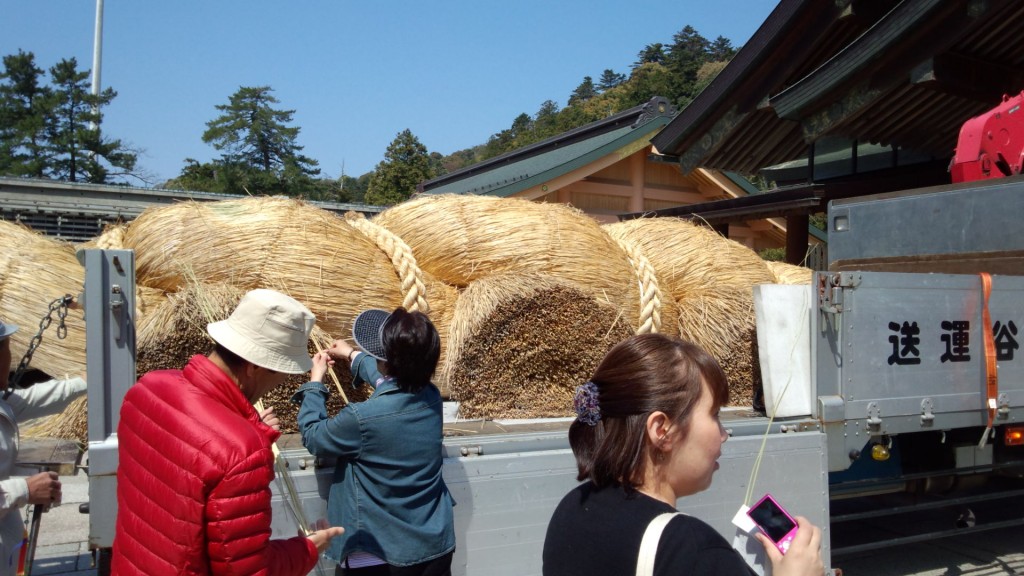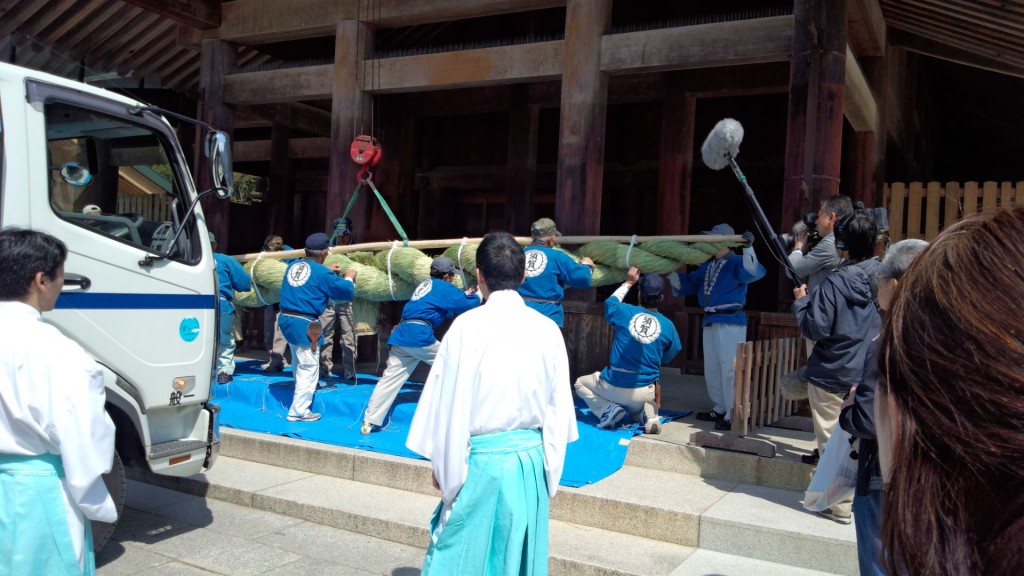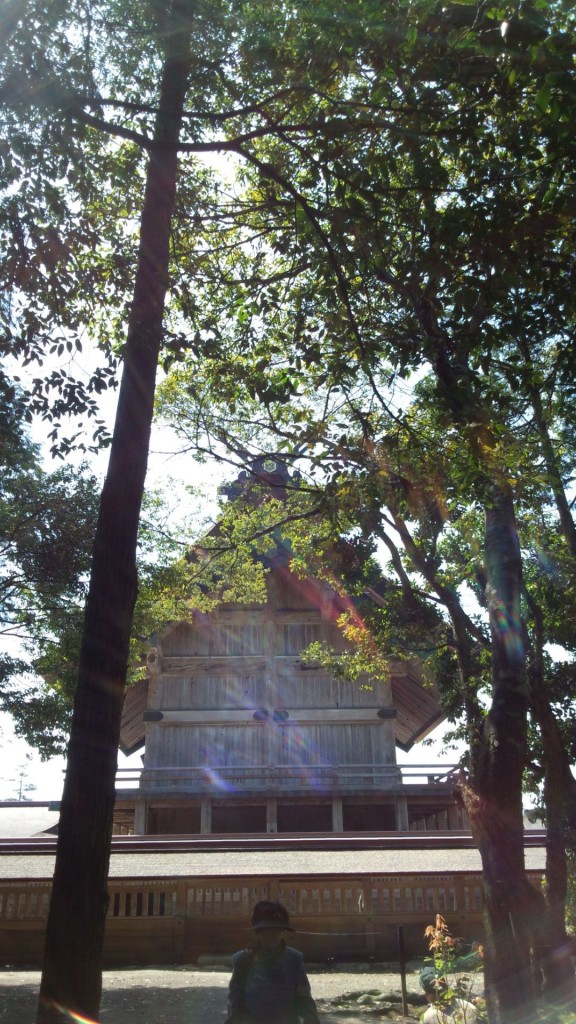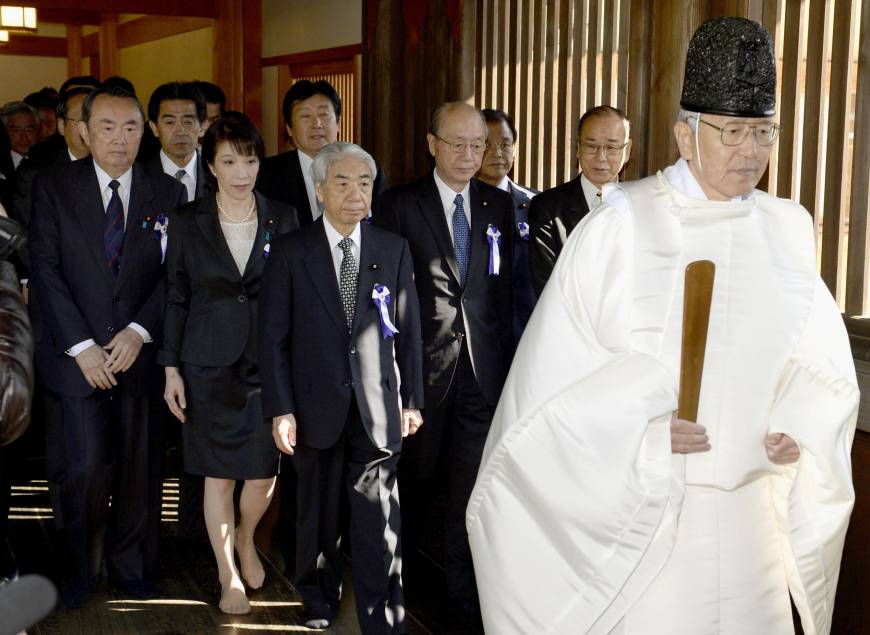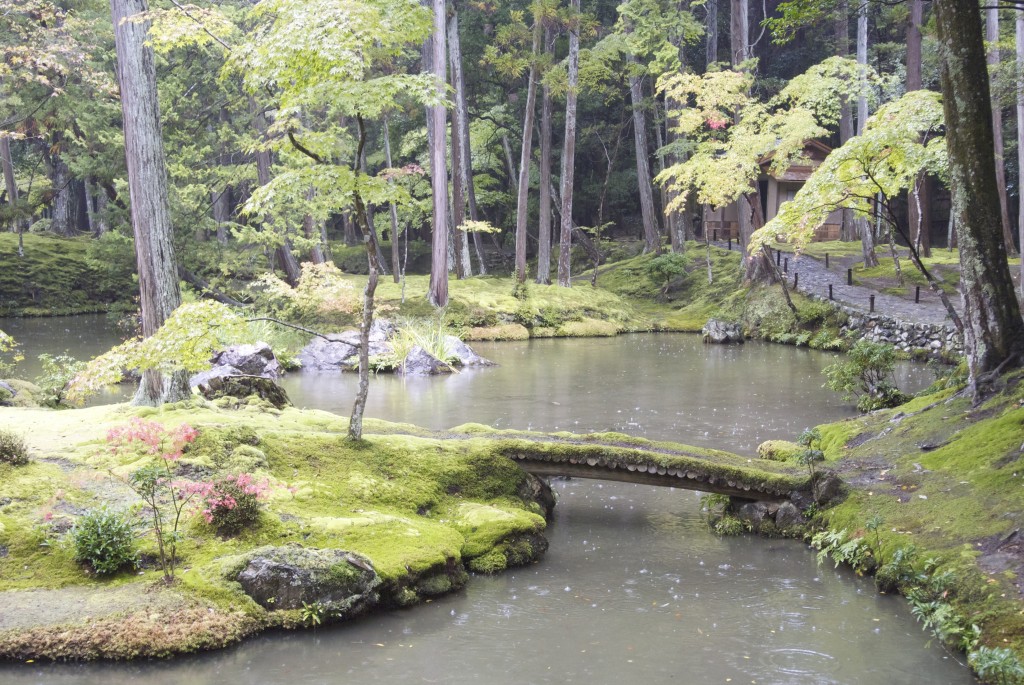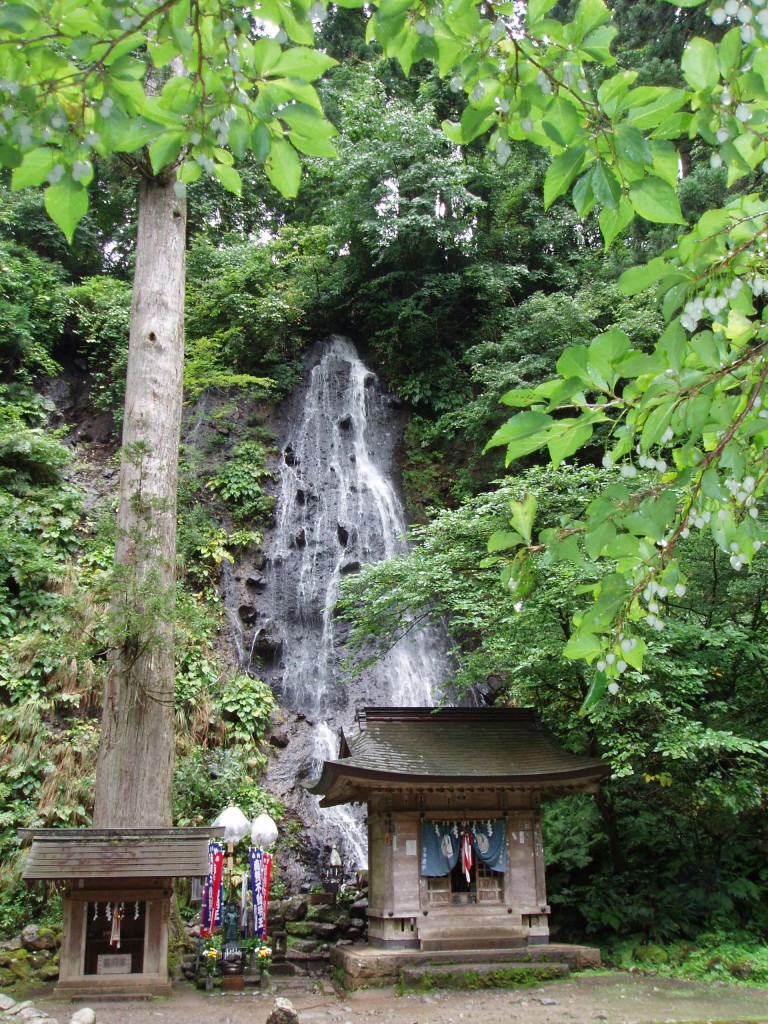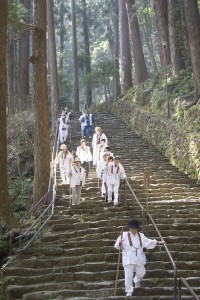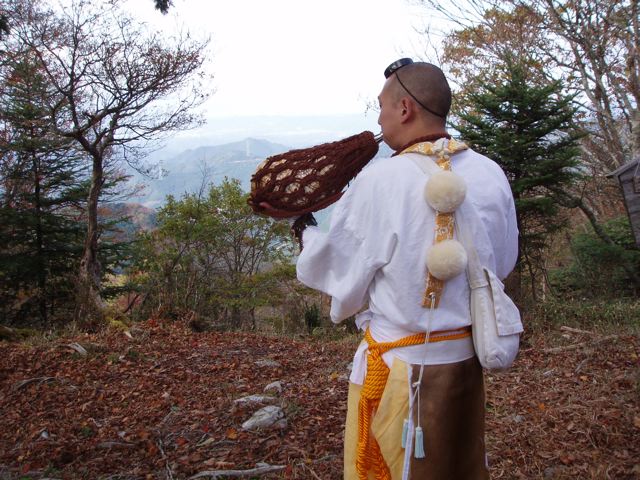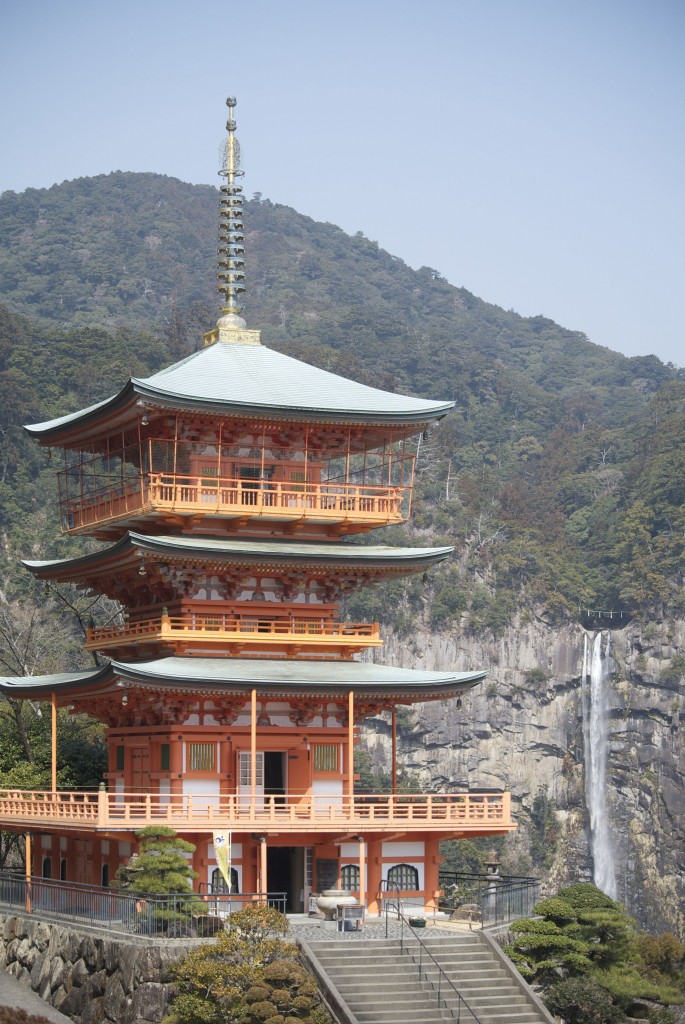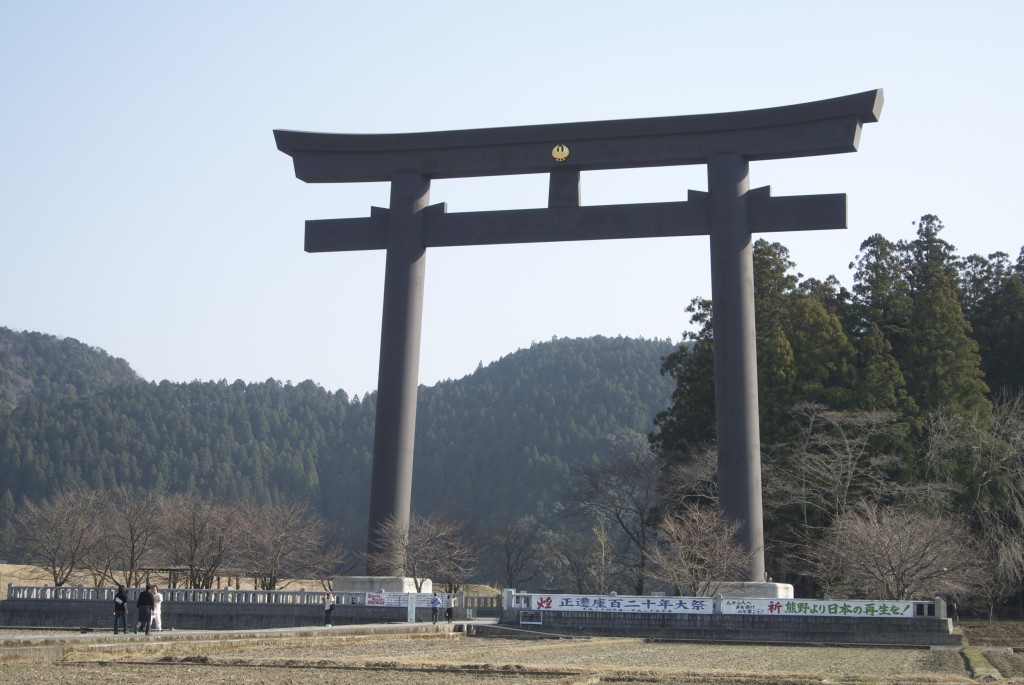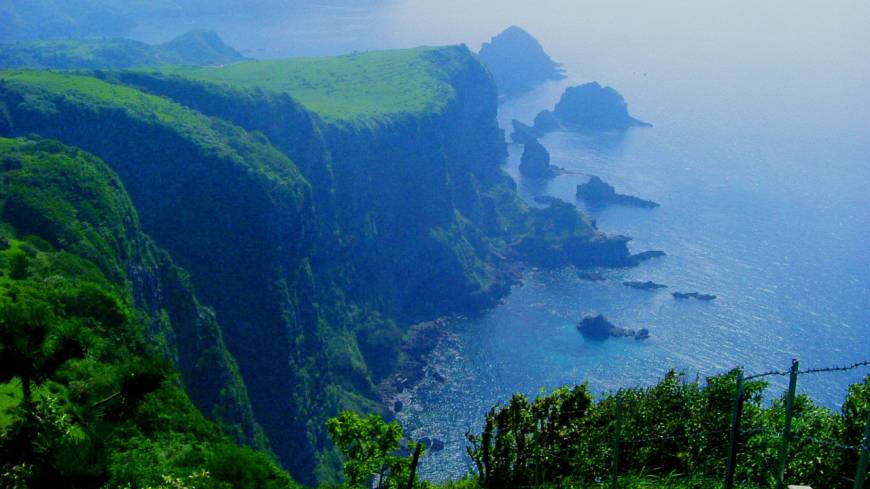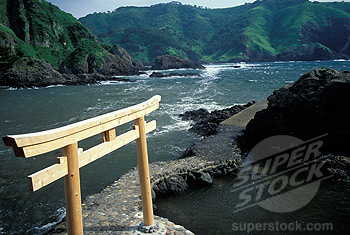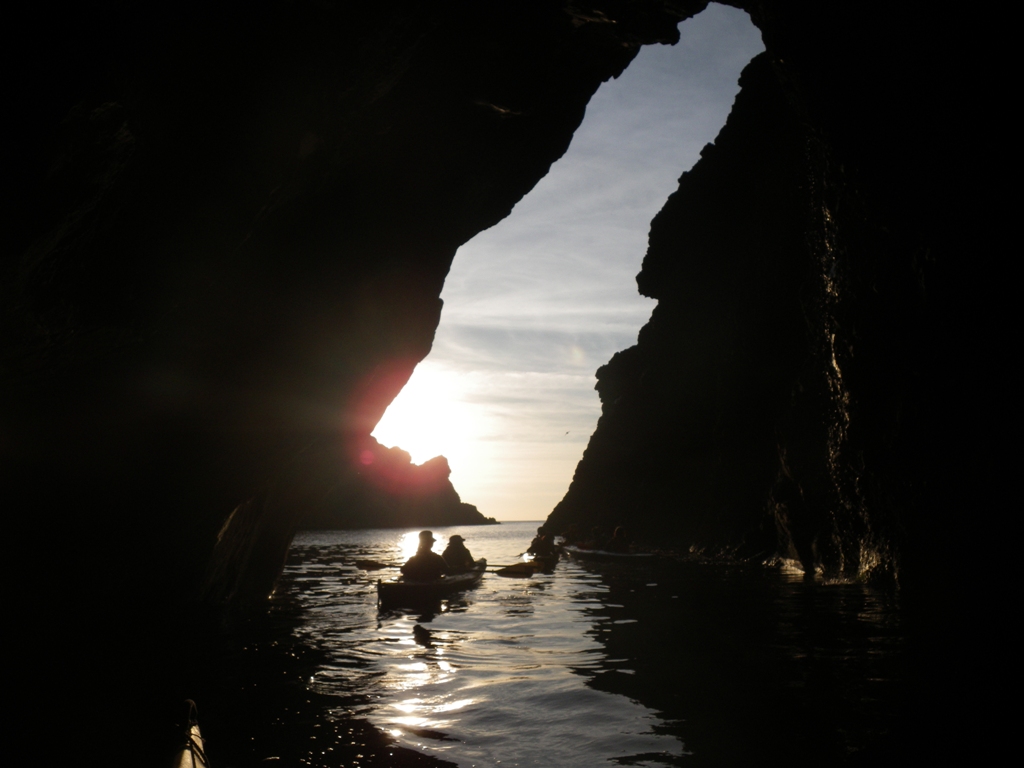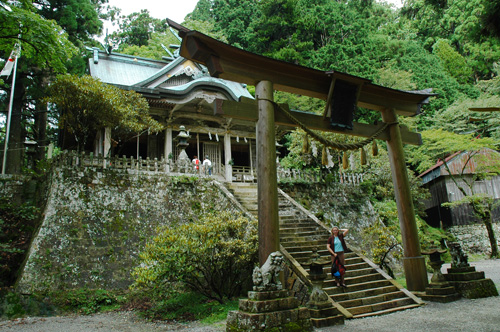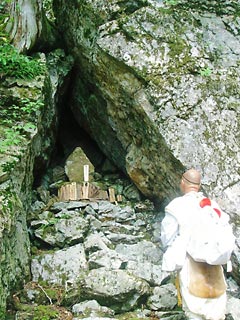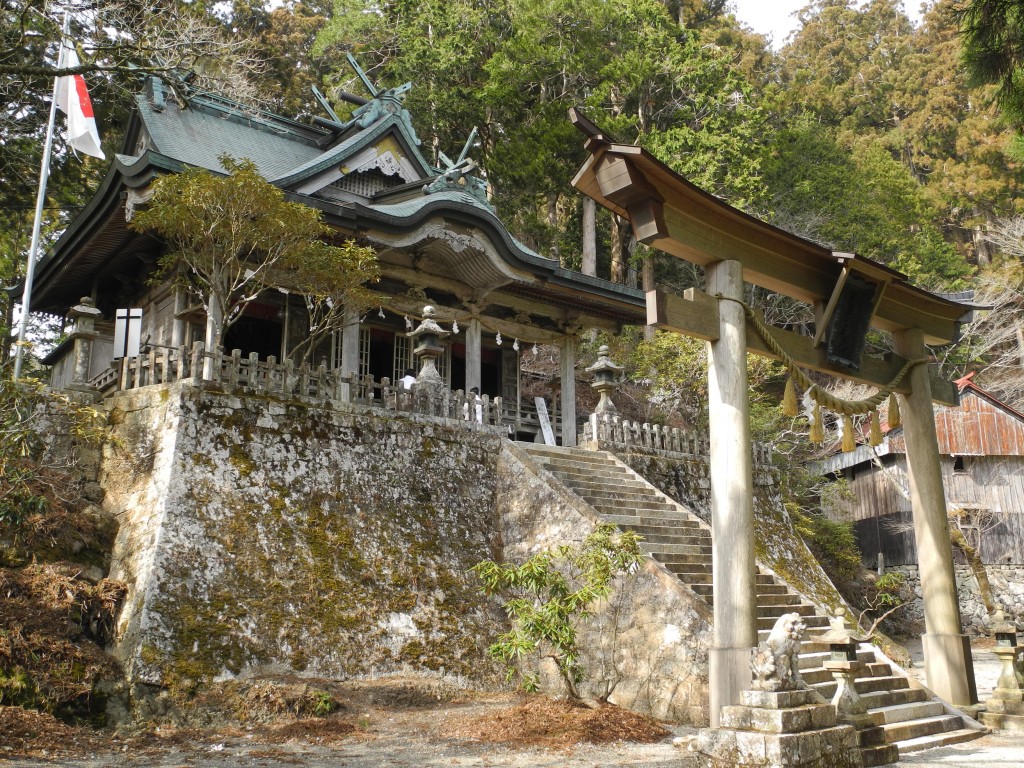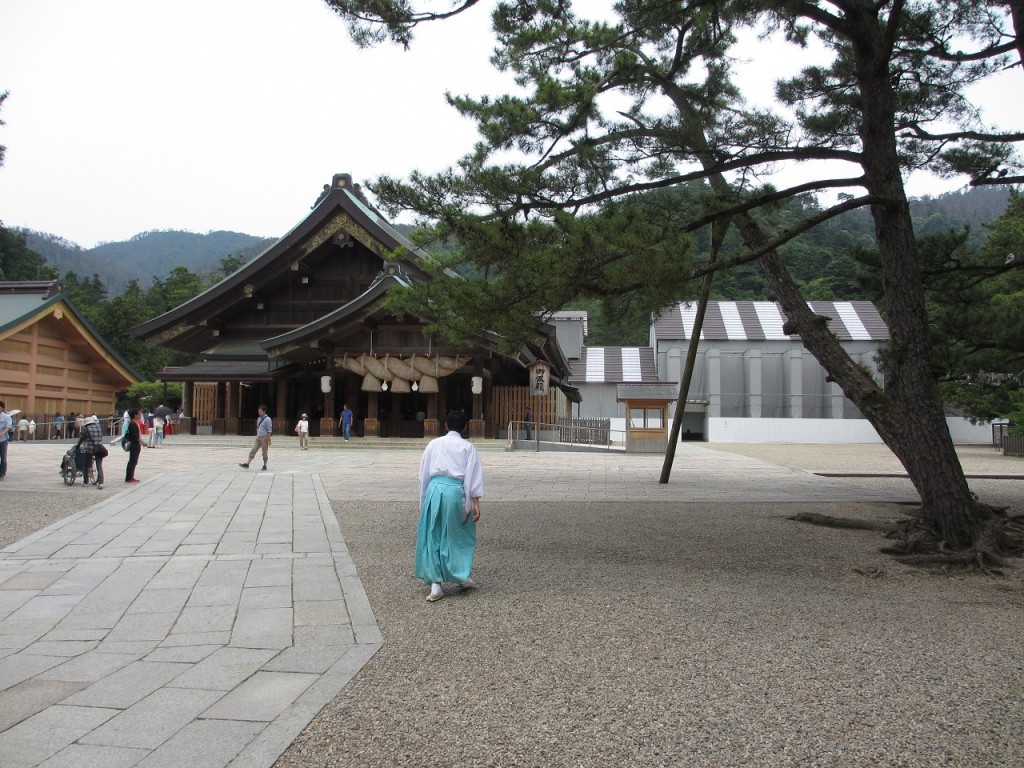
Izumo Taisha, soon to celebrate the completion of its 60-year cycle of renewal (courtesy Connect Shimane)
By now most people have heard of the Ise celebrations this year for the completion of its 20 year shikinen sengu cycle of renewal. The buildings will have been reconstructed, the furnishings remade, and the long series of festivals involved in the process will peak in October with the removal of the sacred mirror of Amaterasu behind a veil of protective cloth to its new housing.
Prior to the Ise celebrations, however, are those of Izumo which take place on a 60 year cycle. It means 2013 is literally a once in a lifetime concurrence of the two major renewals. David Jones, a “Shimane Kentohshi Ambassador for Tourism”, has contacted Green Shinto about his Connect Shimane blog site, which carries useful information about the series of events lined up to celebrate the completion of Izumo’s shikinen sengu, and it’s a hugely impressive programme – it really does seem a once in a lifetime occasion. There is a full listing in Japanese at this link, but for a quck overview I’ve included the activities in English below.
Incidentally, anyone with a few spare moments may like to look at the Connect Shimane website and the impressive slide show with accompanying music. It’s an upliftingly beautiful, almost spiritual, series of photographs. Click on the music button on this link, then sit back and soak in the atmosphere of one of Japan’s most folkloric areas. http://www.connect-shimane.com/
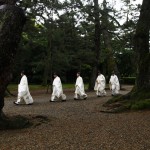
Suzumidono Matsuri (courtesy Connect Shimane)
Schedule of celebrations
May 10th (Fri)
*Honden Senza-sai (Priests relocates Ohkuninushi’s spirit back to the newly renovated Honden, the main sanctuary building)
11th (Sat)
*Honden Senza Housei-sai (The Emperor’s messenger visits the Honden and presents the Emperor’s offering)
12th (Sun)
Gagaku (Imperial Court music and dance, by Kasuga group from Nara)
Izumo kagura
13th (Mon)
*Rei-sai Zenya-sai (Reisai-Eve ritual)
Izumo kagura
Nihon Buyo (Japanese dance) by top Japanese Hanayagi male dancers (Juraku Hanayagi and Noriyuki Hanayagi)
Iwami kagura
14th (Tue)
*Tekisha-sai (archery)
*Rei-sai (Izumo Taisha’s most important annual festival. The Emperor’s messenger visit Honden and present the Emperor’s offering)
Izumo kagura
Joint concert by Hohzan Yamamoto (National Treasure Shakuhachi player) and internationally-know guitarist Hideshi Takatani
Ryukyu-mai dance (Okinawa traditional dance) by Okinawa dancers
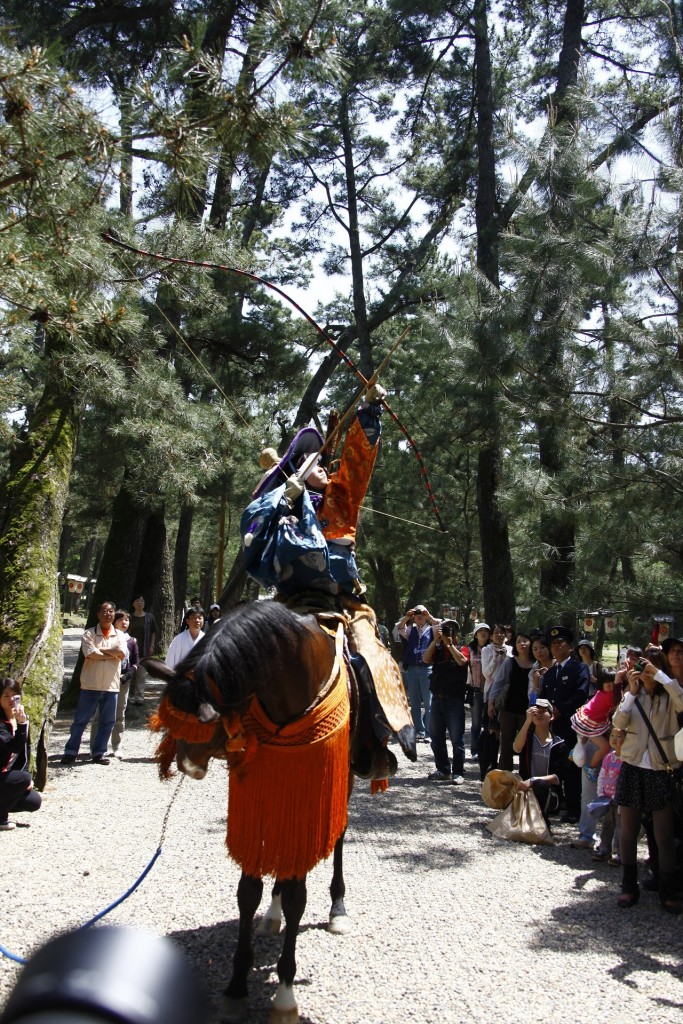
Horseback archery on May 26th (courtesy Connect Shimane)
15th (Wed)
*Rei-sai Ni-no-matsuri (extended Rei-sai)
*Mikoshi Gyo-sai (carriage baring Ohkuninushi’s minor spirits will carried around Taisha Town)
Kemari (imperial court ball game) by Konpira-gu Kemari group, Kagawa Prefecture
Yakumo-goto (2 string chin), by Yakumo-goto group, Ehime Prefecture
Izumo Kagura
16th (Thu)
Reisai San-no-matsuri (extended Rei-sai)
*Izumo Yashiki Kansha Daisai (local warshipper’s thanks-giving to Ohkuninuchi)
Izumo Kagura
17th (Fri)
Izumo Kagura
Iwami Kagura
18th (Sat)
*Okagura-sai (the end of Rei-sai festivals)
Iwami Kagura
Johmon Daiko (drum) concert by Gohshin Moro, a bongo drummer
Kagura drama ‘Susano-o’ by Izumo Taisha branch from Hiroshima Prefecture
19th (Mon)
Iwami Netsuke exhibition, exhibition of Takamado-no-miya Collection (Mikasanomiya branch of the Imperial family)Kitcho ritual (a group of masked men walk around Taisha Town beating the ground with bamboo sticks for good luck)
Renge-e-mai dance from Kokubunji Temple, Oki Islands (This dance is said to be danced only in Oki, outside the Imperial Palace).
Taue-mai (300 year-old rice seedling planting dance) by a group from Fukushima Prefecture
Ohura Kagura, from Iwate Prefecture
Iwami Kagura
20th (Tue)
Acoustic Concert by the artists born in Shimane
Brass Ensemble by Kohichi Inoue, Junichi Yoshikawa etc
21st (Tue)
Tsugaru Kagura by Izumo Taisha branch in Aomori Prefecture
Izumo Kagura
22nd (Wed)
Izumo Kagura
Iwami Kagura
23rd (Thu)
Iwami Kagura
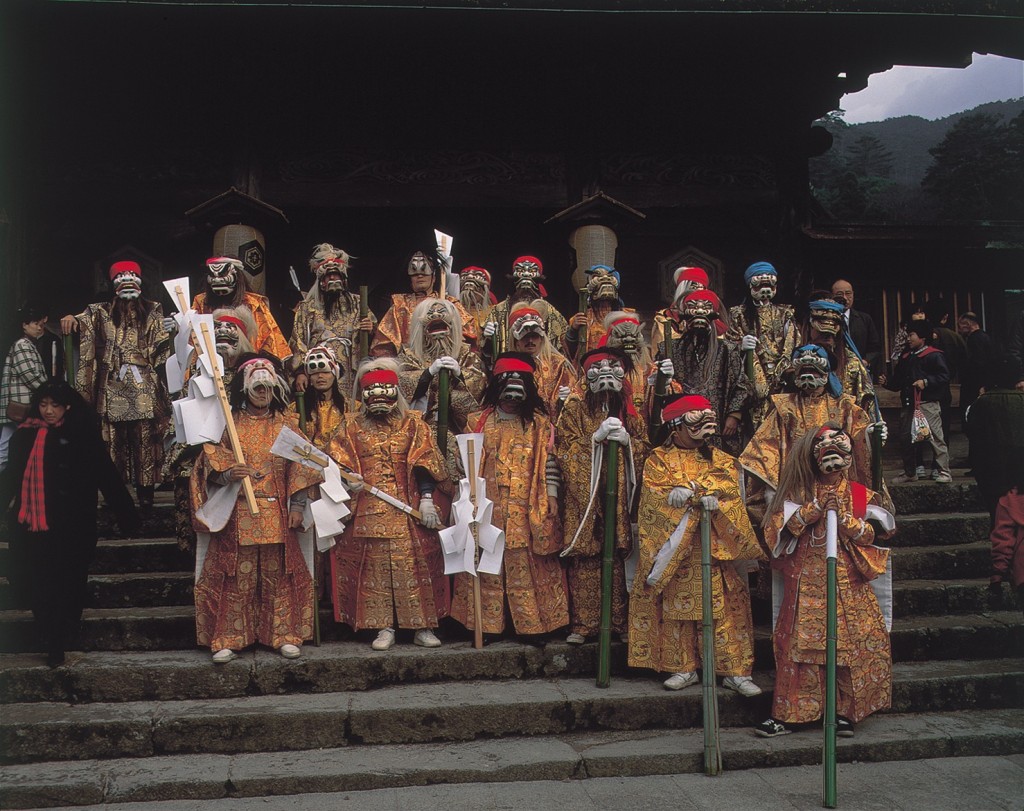
A group of masked men walk around town beating the ground with sticks in an event known as Kitchou-sai on May 19 (courtesy Connect Shimane)
24th (Fri)
Iwami Kagura
Izumo Kagura
‘Creation of Izumo Taisha’ story narrated by Atsuko Asano, A famous actress having close association with Izumo myths
25th (Sat)
Oki Kagura
Houin Kagura, 400-year old kagura from Miyagi Prefecture, kagura created mainly by mountain ascetics
Mai-hyashi, Shimai (type of Noh dance) by Izumo Taisha branch from Kohchi Prefecture
26th (Sun)
Izumo Kagura
Tea ceremony by the master of the Sansai School of Tea Ceremony, Izumo City
Noh by Ujin Sakurama, a Living National Treasure, and Kyogen by Mansai Nomura, talented Kyogen dancer and actor.
‘Heisei Grand Sengu’ series were written specially for the occasion, and ‘Sengu’ is performed this time.
Horse-back archery ritual
27th (Mon)
Iwami Kagura
Horse-back archery, Ogasawara-ryu school of archery from the Kamakura period (AD 1185-1333)
Japanese dance by Sakon Murayama
Lectures on ‘Ohkuninushi’ by Prof. Suzuka, Tohjuurou Sawamura etc
Live performance by comedians born in Shimane
28th (Tue)
Sumo Grand Champion Harumafuji ceremonial ritual display.
Harumafuji (29 year-old Mongolian, 70th Grand Champion) – ritual
Anminishiki (35 year-old, highest ranking Sekiwake, from Aomori Prefecture) – Sword-bearer
Okino-umi (28 year-old, highest ranking Maegashira, local favourite from Oki Island) – Tsuyuharai (attending wrestler)
36th Shohnosuke (Highest ranking referee, the name is inherited) – Referee
Iwami Kagura
Gagaku by Ono Gagaku Group, Tokyo
29th (Wed)
Iwami Kagura
Unryu and Myu joint concert (Unryu is a flutest, Myu is a ‘healing singer’)
30th (Thu)
Iwami Kagura
Izumo Kagura
31st (Fri)
Oku-izumo Kagura
Izumo Kagura
Hideki Tougi Concert (Gagaku player by training/multi instruments player/actor) with: –
Madoka Sugai, multi award-winner ballet dancer (currently at Das Bundesjugendballett, Hamburg)
French artist Markestel (Mark Squarchiafichi)’s paintings of Kojiki, projected on screen at the same time
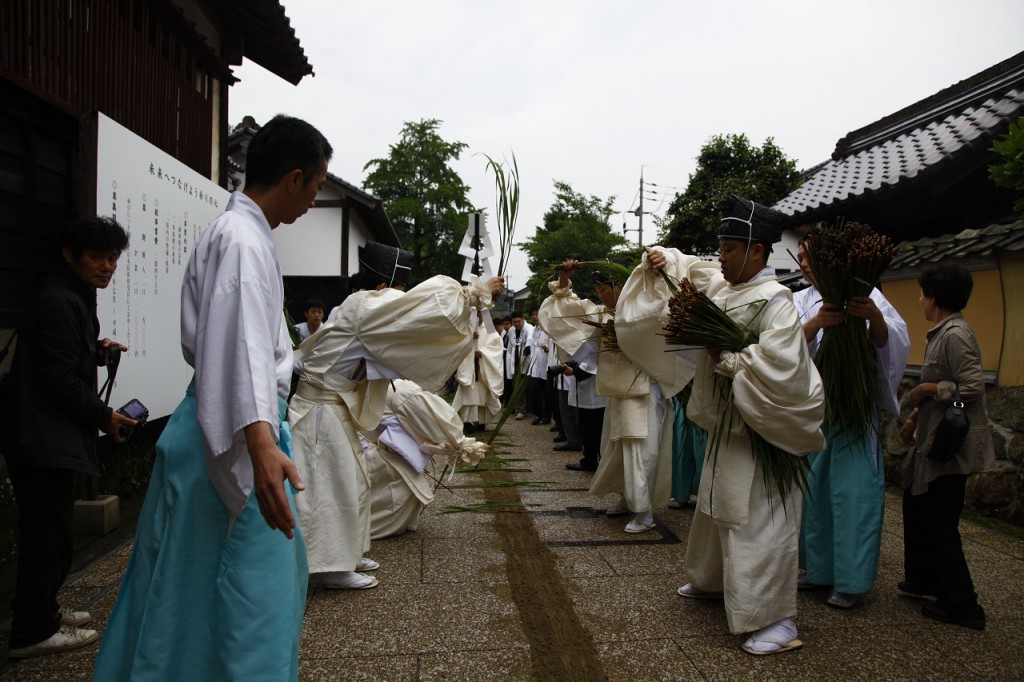
Suzumidono Matsuri: description below (courtesy Connect Shimane)
June 1st (Sat)
*Suzumidono-matsuri (Izumo Taisha’s annual ritual, the head priest walks over a path scattered with new sand and Makomo (marginal plant, Zizania latifolia). The iris-like leaf is said to bring healthy life and good harvests when taken home afterwards.
Iwami Kagura
Izumo Kagura
2nd (Sun)
Izumo-no-kuni Shinbutsu Reijyo (Shinto shrines and Buddhism temples in Izumo Region) joint prayers for world peace
Izumo Kagura
Iwami Kagura
Matsue Dou Gyoretsu (large drum procession)
3rd (Mon)
Iwami Kagura
Special Concert by Masayoshi Yamazaki (musician/singer-songwriter/actor) and Chitose Moto (Okinawa folk song singer)
4th (Tue)
Iwami Kagura
Azumi Inoue Family Concert, by a well-known singer (sung the theme song of the animation ‘Totoro’)
5th (Wed)
Iwami Kagura
Eitetsu Hayashi Drum Concert (Japanese drums)
6th (Thu)
Yasugi-bushi folk song and most famous comical dance associated with the song from Yasugi City, ‘Dojou-sukui’ (mini eel catcher). Of course they do not use eels on stage!
Iwami Kagura
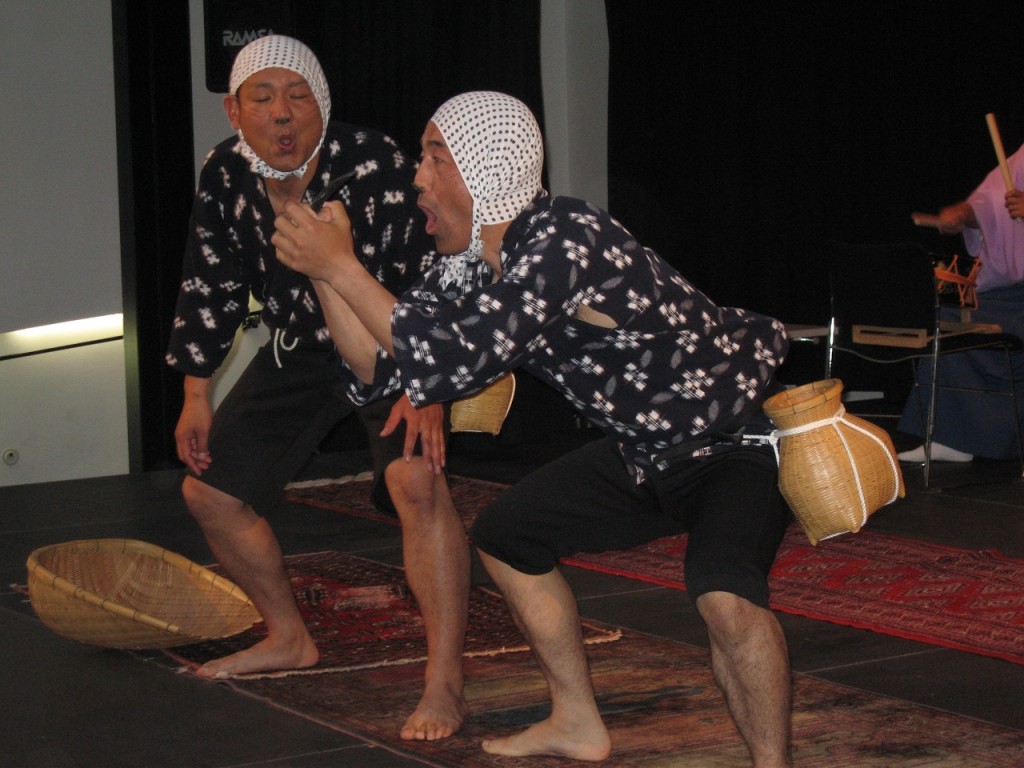
Dojou-sukui, the mini-eel catchers (courtesy of Connect Shimane)
7th (Fri)
Iwami Kagura
Megumi Abiko Concert (Japanese guitar player using Tsugaru/Okinawa shamisen-guitars and western guitars)
Hiromi Yamaguchi Concert (Japanese Enka singer)
8th (Sat)
Izumo Kagura
‘Invitation to Japanese Myths’ narrated by Maki Mizuno, Japanese acress
9th (Sun)
Izumo Kagura
Iwami Kagura
